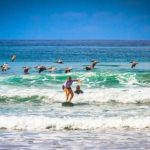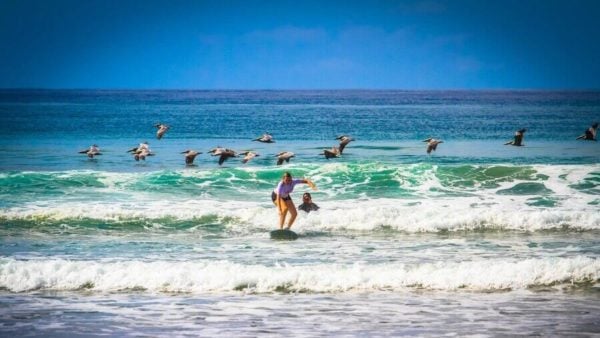Costa Rica is renowned for its consistent waves, warm water, and diverse coastline, offering conditions suitable for beginners, intermediates, and advanced surfers alike. Its two coasts—the Pacific and the Caribbean—provide varied surf experiences, from gentle beach breaks to powerful reef breaks. Coupled with stunning scenery and vibrant surf culture, costa rica surfing has become a must-visit destination for surfing enthusiasts.
Which coast is better for beginners: Pacific or Caribbean?
For beginners, the Pacific coast is generally recommended. Beaches such as Tamarindo, Nosara, and Playa Hermosa offer mellow waves and sandy bottoms, ideal for learning and practicing. The Caribbean coast, while beautiful, often has more unpredictable surf and stronger currents, making it better suited for those with some experience.
What are the best surfing spots for beginners in Costa Rica?
- Tamarindo: Known for its long, gentle waves, this spot is perfect for first-time surfers. Numerous surf schools provide lessons and equipment rental.
- Playa Guiones in Nosara: Offers consistent, small waves, and a welcoming surf community.
- Jaco Beach: Easy access from San José and a variety of breaks make it suitable for learners.
Which spots are ideal for intermediate surfers?
Intermediate surfers often look for more challenging waves without extreme risk. Recommended spots include:
- Santa Teresa: With long beach breaks and occasional reef sections, it allows progression in skill.
- Dominical: Offers more powerful waves and a chance to practice turning and carving.
- Playa Hermosa (Puntarenas): Known for its consistent swells and clean wave faces, excellent for improving techniques.
Where can advanced surfers find thrilling waves?
Advanced surfers seeking intense waves and challenging breaks can head to:
- Witches Rock (Playa Naranjo): Famous for its barreling reef breaks, ideal for experienced surfers.
- Ollie’s Point (Guanacaste): A long, fast, and hollow right-hand point break that demands skill and timing.
- Pavones: One of the longest left-hand point breaks in the world, providing a unique challenge for advanced surfers.
What is the best time of year to surf in Costa Rica?
Costa Rica has two main seasons: dry (December to April) and rainy (May to November).
- Pacific coast: The rainy season brings bigger swells, ideal for intermediate and advanced surfers. The dry season offers smaller, manageable waves for beginners.
- Caribbean coast: Swells are generally more consistent from November to May, but conditions can vary.
Are there surf schools available across the country?
Yes, Costa Rica has numerous surf schools catering to all skill levels. Many schools provide lessons in Spanish or English and include safety instructions, board rental, and guided sessions. Popular locations like Tamarindo, Nosara, and Jaco have well-established schools that also organize surf camps for immersive learning.
Is it necessary to bring your own surfboard?
While many experienced surfers prefer to bring their own boards, beginners and casual travelers can rent boards easily. Most surf towns have rental shops offering a range of boards for different skill levels. Rental rates are typically reasonable, and instructors often provide boards for lessons.
What safety measures should surfers follow in Costa Rica?
- Always check local surf reports before entering the water.
- Be aware of rip currents and learn how to exit them safely.
- Surf with a buddy, especially at more challenging breaks.
- Respect local rules and surf etiquette to ensure safety and harmony in the water.
Can surfing in Costa Rica be combined with other activities?
Absolutely. Costa Rica is famous for adventure tourism. Many surfers enjoy combining surf trips with activities like zip-lining, wildlife tours, hiking volcanoes, or exploring waterfalls. Surf towns often have vibrant local culture, restaurants, and nightlife, making them perfect for balanced travel experiences.
Are there surfing competitions held in Costa Rica?
Yes, Costa Rica hosts international and local surfing competitions. Events such as the Costa Rica Surf Classic and various ISA (International Surfing Association) qualifiers attract top surfers and offer spectators a chance to experience professional-level waves. Attending a competition is also an excellent way for surfers to learn new techniques by observing experts.
What makes Pavones unique among Costa Rican surf spots?
Pavones is famous for its exceptionally long left-hand point break. Under ideal conditions, rides can last several minutes, offering a rare experience for advanced surfers. The remote location adds to its appeal, providing both adventure and impressive natural surroundings.
Are there eco-friendly surf options in Costa Rica?
Yes, many surf schools and accommodations promote sustainable practices, including reef-safe sunscreen, eco-conscious board maintenance, and beach cleanup initiatives. Costa Rica’s commitment to environmental conservation aligns well with the values of surfers who care about protecting coastal ecosystems.
Can children learn to surf in Costa Rica?
Yes, many surf schools welcome children and provide safe, beginner-friendly lessons. Shallow beach breaks, smaller boards, and professional instructors ensure that young surfers can enjoy learning while developing skills in a secure environment.
What should travelers pack for a surfing trip to Costa Rica?
- Lightweight, quick-dry clothing and swimwear
- Rash guard or surf shirt for sun protection and comfort
- Reef-safe sunscreen and sunglasses
- Water shoes if visiting rocky or reef areas
- Travel insurance that covers surfing activities
Is it possible to find quiet, less crowded surf spots?
Yes. While popular beaches attract many surfers, Costa Rica has numerous hidden gems. For example, Playa Avellanas and Playa Negra in Guanacaste offer excellent waves with fewer crowds. Research and local advice are key to discovering these tranquil spots.
How does the Costa Rican surf culture feel?
Costa Rica has a relaxed, welcoming surf culture. Locals, known as “Ticos,” are friendly and often happy to share tips on waves and conditions. Surf towns feature casual beachside cafes, surf shops, and community events that create a social, supportive atmosphere for surfers of all levels.
Are there accommodations suited for surfers near top spots?
Yes, many surf towns provide accommodations ranging from budget hostels to luxury villas. Surf camps often combine lodging with lessons, equipment rental, and meals, making it convenient for travelers who want an immersive surfing experience. Locations like Santa Teresa, Tamarindo, and Nosara are especially popular.
What are some tips for improving surfing skills in Costa Rica?
- Take lessons or attend surf camps for structured guidance.
- Practice consistently and try different types of waves.
- Observe local surfers to understand wave patterns and techniques.
- Record and review your sessions to identify areas for improvement.
Can you surf year-round in Costa Rica?
Yes, Costa Rica’s warm climate and variety of surf spots allow year-round surfing. While conditions vary seasonally, there is usually at least one location offering suitable waves for all skill levels at any time of the year. Planning trips around the ideal swell periods for your ability level ensures the best experience.
How do surf conditions vary between beaches?
Different beaches offer different wave types. Beach breaks are generally easier, while reef and point breaks are more challenging and often faster. Tide, swell direction, and wind can drastically affect wave quality. Local surf reports or guidance from instructors help surfers select the right spot for their skill level.
Are there surfing events for amateurs?
Yes, many local surf contests welcome amateur participation. These events are great for building confidence, meeting other surfers, and learning competition techniques in a friendly environment. Some towns even host annual surf festivals that combine sport with cultural activities.
How important is timing your visit to coincide with swells?
Timing is crucial. Experienced surfers often plan trips to coincide with peak swells for maximum wave quality. Beginners may prefer calmer conditions. Monitoring surf forecasts and consulting local instructors ensures that you experience waves that match your skill level.
What is the role of surf etiquette in Costa Rica?
Respecting surf etiquette is essential for safety and maintaining a positive experience. Key practices include:
- Taking turns and not dropping in on others’ waves
- Respecting local surfers and learning about local customs
- Avoiding overcrowded areas if possible
Are there eco-friendly accommodations for surfers?
Yes, several surf camps and lodges prioritize sustainability, using solar energy, recycled materials, and promoting reef-safe practices. Staying in these accommodations helps support environmental preservation and aligns with Costa Rica’s eco-conscious tourism initiatives.
How can surfers maximize their experience in Costa Rica?
- Plan trips during optimal swell seasons for your skill level.
- Choose a mix of popular and hidden surf spots to explore variety.
- Combine surfing with cultural and nature experiences.
- Engage with local surf communities to learn tips and meet fellow surfers.
Why should every surf enthusiast consider Costa Rica?
Costa Rica offers a combination of consistent waves, diverse surf spots, warm waters, and breathtaking natural scenery. The welcoming surf culture, availability of lessons and camps, and opportunities for eco-conscious travel make it a top choice for surfers of all levels seeking adventure, skill development, and a memorable experience.









